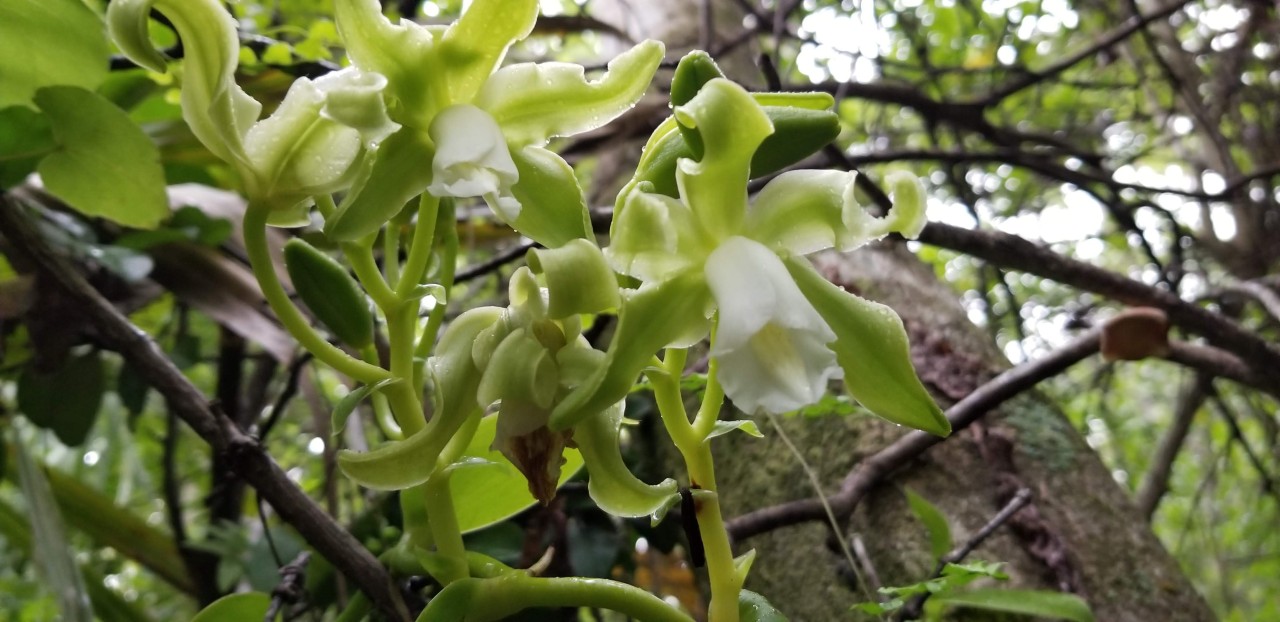
Vanilla species highlight: V. mexicana
V. mexicana is my favorite native vanilla species. I’ve spent a lot of time obtaining permits to work with this species, trudging through swamps to find it, and figuring out how to work with it at the genetic level. What makes it my favorite species? It’s not for commercial interest. The species is scentless so you couldn’t make vanilla extract from it. Well, you could technically make extract, but it would be pointless as the extract wouldn’t smell like anything. Plus, I’m not aware of anyone that consumes the beans of this species, so it’s inadvisable from a food safety standpoint. Certainly its flowers are beautiful. The dark green petals highlight the beauty of the brilliant white lower petal. There’s a little more to it, though, and I think it includes the basic allure of the vanillas. I’ll illustrate with a story.
V. mexicana is an endangered species that is native to southern Florida, parts of Central America, and some islands of the Caribbean. I have permits to work with this species as part of my plant conservation work in collaboration with park biologists. My first adventure to find V. mexicana plants started early one morning at a swamp in an undisclosable nature preserve (secrets make for a good story). We headed out into the southern part of the preserve to locate V. mexicana plants. Walking through a swamp is an interesting endeavor. At first you try to avoid puddles, thorns, and palm leaves in a frivolous attempt to keep up appearances. A few hours later everyone ends up looking like skunk apes and bleeding from wounds gifted by the massive thorns that seem to be attached to everything.
We walked for a long time, but it was probably only a few hundred meters (or yards). Distances are weird in the swamp. You can’t see very far because of the mess of plant life, and there are no paths. Actually, if you find a path or a small clearing, I would stay away from it just in case it was made by an alligator. Regardless, the park biologist yelled out that he had found a plant. I couldn’t see it until I was right next to it. This fragile little vine growing on the side of what had once been a massive tree. The vine grew about 8 feet up the trunk of the decomposing tree. There were little scentless pods that had dried and split showing the dark seeds within. We had actually found our little plant in this wilderness.
I went on many other trips to search for V. mexicana. Once I headed north instead of south. I walked for an hour and came across the largest and most beautiful specimen I’ve ever encountered. It was loaded with around 20 of those beautiful white flowers. I sat on a nearby log and took my time just enjoying how lucky I was to have come across this plant. I wondered about all of those flowers. Would they make beans? Would this plant just keep growing and growing? The answer to both questions was no.
Hurricane Maria came through in September 2017. I went back to collect data on my V. mexicana plants after the storm and found the nature preserve transformed. Normally the trees form a canopy that protects the light-sensitive plants like V. mexicana, but many trees were downed and the swamp had far too much light reaching the ground. I spent a lot of time climbing over felled trees or trying to keep from losing my shoes in the impressively sticky mud. I eventually found my prized specimen, or what was left of it. A palm tree has crashed on the exact spot where the vine had previously grown and had taken a percentage of the entire population with it. For me, this is the definition of what it means to be endangered.
So, maybe V. mexicana is my favorite because it’s pretty. Maybe I’m intrigued by its ability to produce vanilla pods without manual intervention. Maybe I like how fragile the species is, or how getting lost in the swamp feels like I’m finding something missing from the jungle of Miami. Regardless, I’m fortunate to be able to work with some of the diversity within the vanilla genus, and I now know to wear thick pants when I wander the swamps.

PhD candidate in Nematology
3yVanilla hunting in the swamp is far from a pleasant trip, but the satisfaction is enormous and priceless. Glad to have been part of this adventure.